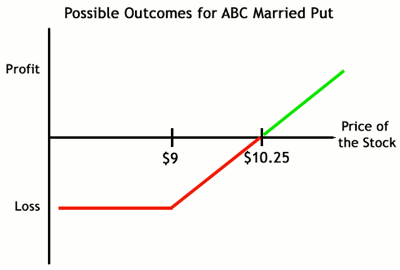Put options can be a terrific way to buy “insurance” on your portfolio. When the price of the underlying equity begins to fall, the value of a put option on that stock will generally begin to rise (more or less based on a variety of factors, including how long the option has until expiration). Often brokers will provide the ability to write covered calls and use married puts when you open your account and complete several forms specifically for trading options. This article will focus on the function of married puts in a portfolio or as part of a trading strategy.
Married puts refer to the combination of two different purchases: one of a stock position and one of a put option. Let's consider the following purchase. Let's say you choose to buy 100 shares of XYZ for $20 per share and one XYZ September $17.50 put for $0.50 (100 shares x $0.50 = $50). With this combination, you have purchased a stock position with a cost of $20/share but have also bought a form of insurance to protect yourself in case the stock declines below $17.50 before the expiration (third Friday in September). You should remember that for a put to be considered "married," the put and the stock must be bought on the same day, and you must instruct your broker that the stock you have just purchased will be delivered if the put is exercised.
Does a Married Put Make Sense?
When you actually think about it, why would anyone ever choose to employ this particular strategy? Some of you might think that it's almost like buying a stock and knowing that it will fall to pieces! That is an interesting argument, but a married put should be looked at as a form of insurance rather than as an expectation of a certain outcome. In essence, you are expecting an appreciating stock price, but you are also preparing yourself in case your stock takes a steep plunge.
Obviously, you can't purchase put protection for every stock in your portfolio because such costs would significantly eat into your portfolio's returns over time. You can, however, use a married-put strategy in certain circumstances, particularly if you are unsure about a certain stock. How many times have you bought a stock only to slap your forehead in disgust when reading a quote a few days later? With a married put, your downside is protected—an idea that is quite appealing in today's market.
Practice Makes Perfect
Consider the following example. Today is January 1 and you purchase 200 shares of ABC at $10/share and two February $9 puts for $0.25 ($25 per contract). You have also told your broker that you intend for this to be a married put transaction, so let's consider whether this position makes for a good trade.
In any transaction, you have to gauge your exposure, or your risk. In the given example, you have a total cash outlay of $2,050 (excluding commissions). You have paid $2,000 for the stock and $50 for your insurance policy. If the stock goes up above $10.25, you are now in a profit position on paper and won't have to consider the put option because it will expire worthless. If, however, ABC plummets to $6 a share, then the value of the insurance quickly becomes apparent. If you were faced with a stock value of $6 at the February expiry, you would be looking at a loss of $250 (200 x [10.25-9.00]). Contrast this with the loss you would have incurred without the married put strategy: $800 (200 x [10.00-6.00]).
As you work through the example, it becomes obvious that a married put makes a lot more sense for an investment in which you expect an event to raise the price significantly, which, if left undelivered, will result in a dramatic fall. Such a situation might be an upcoming earnings release date, when the company will either deliver positive cash flow or lose its credibility completely. In such a case, a married put can protect your downside while allowing you to participate fully in any upside (unlike a covered call, which limits your potential gains).
Things to Consider Before You Tie the Knot
If you are new to options, your broker might limit your exposure to puts by confining you to married put positions. Because two investments are tied together, you will be sure to have shares available if the put is exercised. This also means that as long as the option is outstanding, you cannot sell your shares; furthermore, unlike a covered call, a married put does not increase the value of your portfolio over time—because you are buying the put option, you are incurring a cost for the price of this protection. Any costs, whether they are trading fees, insurance, commissions, or management expenses, are all factors that lower your return. This is an important point to remember when considering put options for your portfolio.
Conclusion
Married puts are one of the few ways that a new investor can protect the downside of an investment. This protection comes at a cost, and it is important to use this strategy only in certain situations. If you think that a particular stock will go up, but you are wary of a possible disaster, then the married-put strategy could be quite useful. Married puts can provide a great means of limiting your losses and helping you learn the usefulness of puts in a portfolio. As in any options trade, always make sure that you consider the worst-case scenario.
By the Staff at Investopedia.com






















